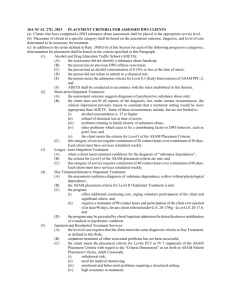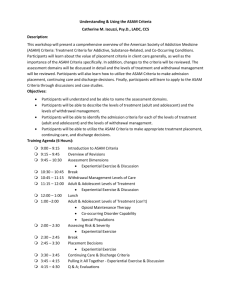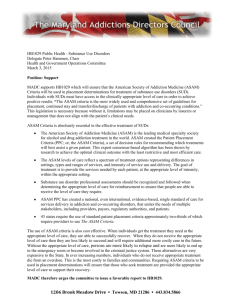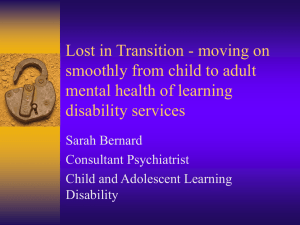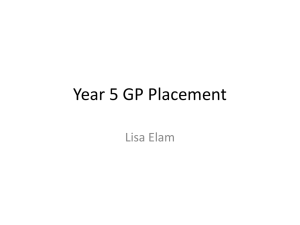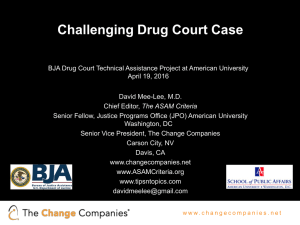Section 18_Patient Placement - UCLA Integrated Substance Abuse
advertisement
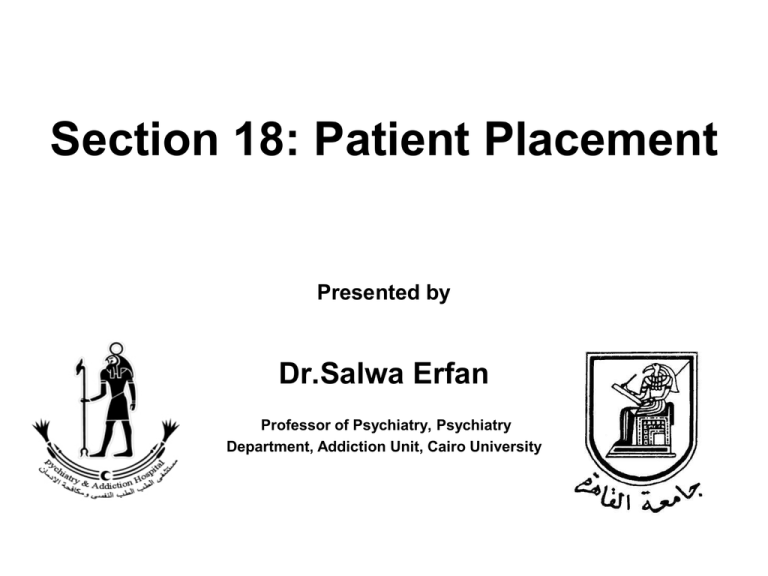
Section 18: Patient Placement Presented by Dr.Salwa Erfan Professor of Psychiatry, Psychiatry Department, Addiction Unit, Cairo University DEFINITIONS Placement matching, a patient is referred to a particular setting. Modality matching attempts to match a patient's needs to a specific treatment approach. • When placement matching is disconnected from modality matching, treatment is likely to be less effective because it fails to respond to the individual needs of the patient. Approaches to Treatment Matching Complications-driven treatment. Diagnosis, program-driven. Individualized, assessment-driven treatment. Outcomes-driven treatment. Uses of Placement Criteria • placement criteria play an integral role by providing a structure for assessment that focuses on the patient's assessed needs. • Criteria also provide a nomenclature to describe an expanded set of treatment options and guideline to promote the use of a broader continuum of services. The placement criteria are intended to Enhance the efficient use of limited resources, Increase patient retention in treatment, Prevent dropout and relapse, Improve patient outcomes. UNDERSTANDING THE ASAM PATIENT PLACEMENT CRITERIA Four features characterize the ASAM Patient Placement Criteria: 1) Individualized treatment planning, 2) Ready access to services, 3) Attention to multiple treatment needs, 4) Ongoing reassessment and modification of the plan. UNDERSTANDING THE ASAM PATIENT PLACEMENT CRITERIA cont • The criteria are based on a philosophy that effective treatment attends to multiple needs of each individual, not just his or her alcohol or drug use. • To be effective, treatment must address any associated medical, psychological, social, vocational, and legal problems. • Through its six assessment dimensions, the ASAM criteria underscore the importance of multidimensional assessment and treatment Principles Guiding the Criteria Goals of Treatment : The goals of intervention and treatment determine the methods, intensity, frequency, and types of services provided. Addiction treatment programs have as their goal not simply stabilizing the patient’s condition but altering the course of the patient's disease. Individualized Treatment Plan: Treatment should be tailored to the needs of the individual The plan should be based on comprehensive bio psychosocial assessment of the patient The plan should list Problems Strengths Priorities Goals methods or strategies timetable Principles Guiding the Criteria cont Choice of Treatment Levels: The goal that underlines the criteria is the placement of patient in the most appropriate level of car. while the levels of care are presented as discrete levels, in reality they represent benchmarks or points along a continuum of services that could be used in a variety of ways, depending on a patient's needs and response. Continuum of Care: Continuum may be offered by single provider or multiple providers. Progress Through the Levels of Care As a patient moves through treatment in any level of care, his or her progress in all six dimensions should be continually assessed In the process of patient assessment, certain problems and priorities are identified as justifying admission to a particular level of care Principles Guiding the Criteria cont Length of Stay: The length of stay or service is determined by the patient’s progress towards achieving his or her treatment plan goals and objectives. Clinical Versus Reimbursement Considerations The ASAM criteria are not intended as a reimbursement guideline, but rather as a clinical guideline for making the most appropriate placement recommendation for an individual patient with a specific set of symptoms and behaviors. Treatment Failure : Two incorrect assumptions are associated with the concept of "treatment failure." The first is that the disorder is acute rather than chronic, so that the only criterion for success is total and complete amelioration of the problem. The second assumption is that responsibility for treatment "failure" always rests with the patient . ASSESSMENT DIMENSIONS The ASAM criteria identify the following problem areas (dimensions) as the most important in formulating an individualized treatment plan and in making subsequent patient placement decisions. Dimension I: Acute Intoxication and/or Withdrawal Potential: . • What risk is associated with the patient's current level of acute intoxication? • Is there significant risk of severe withdrawal symptoms or seizures. based on the patient's previous withdrawal history, amount, frequency and regency of discontinuation or significant reduction of alcohol or other drug use? ASSESSMENT DIMENSIONS cont • Are there current signs of withdrawal? • Does the patient have supports to assist in ambulatory detoxification, if medically safe? • Has the patient been using multiple substances in the same drug class? • Is there a withdrawal scale score available? In the adult ASAM Placement Criteria. Detoxification services can be provided at any of five levels of care . Specific criteria. organized by drug class guide the decision as to which detoxification level is safe and efficient for a patient in withdrawal. ASSESSMENT DIMENSIONS cont Dimension 2: Biomedical Conditions and Complications. • Are there current physical illnesses, other than withdrawal, that need to be addressed because they are exacerbated by withdrawal, create risk, or may complicate treatment? • Are there chronic conditions that affect treatment? • Is there need for medical services that might interfere with treatment? ASSESSMENT DIMENSIONS cont Dimension 3: Emotional, Behavioral, or Cognitive Conditions and Complications • Are there current psychiatric illnesses or psychological, behavioral, emotional, or cognitive problems that need to be addressed because they create or complicate treatment? • Are there chronic conditions that affect treatment? • Do any emotional, behavioral, or cognitive problems appear to be an expected part of the addictive disorder, or do they appear to be autonomous? • Even if connected to the addiction, are they severe enough to warrant specific mental health treatment? ASSESSMENT DIMENSIONS cont • Is the patient suicidal, and if so, what is the lethality? • Is the patient able to manage the activities of daily living? • Can he or she cope with any emotional, behavioral, or cognitive problems? • If the patient has been prescribed psychotropic medications, is he or she compliant? Dimension 4: Readiness to Change • Is the patient actively resisting treatment? • Does the patient feel coerced into treatment? • How ready is the patient to change? ASSESSMENT DIMENSIONS cont • If he or she is willing to accept treatment, how strongly does the patient disagree with others' perception that she or he has an addictive or mental disorder? • Does the patient appear to be compliant only to avoid a negative consequence, or does he or she appear to be internally distressed in a self motivated way about his or her alcohol or other drug use or mental health problem? • At what point is the patient in the stages of change? • Is leverage for change available? ASSESSMENT DIMENSIONS cont Dimension 5: Relapse, Continued Use, or Continued Problem Potential • Is the patient in immediate danger of continued severe mental health distress and/or alcohol or drug use ? • Does the patient have any recognition or understanding of, or skills in, coping with his or her addictive or mental disorder in order to prevent relapse, continued use, or continued problems such as suicidal behavior ? • How severe are the problems and further distress that may continue or reappear if the patient is not successfully engaged in treatment at this time? • How aware is the patient of relapse triggers, ways to cope with cravings to use, and skills to control impulses to use or impulses to harm self or others? ASSESSMENT DIMENSIONS cont • What is the patient's ability to remain abstinent or psychiatrically stable, based on history? • What is the patient's current level of craving and how successfully can he or she resist using? • If on psychotropic medications, is the patient compliant? • If the patient has another chronic disorder (such as diabetes), what is the history of compliance with treatment for that disorder? Dimension 6:Recovery Environment • Do any family members, significant others, living situations, or school or work situations pose a threat to the patient's safety or engagement in treatment? ASSESSMENT DIMENSIONS cont • Does the patient have supportive friendships, financial resources, or educational or vocational resources that can increase the likelihood of successful treatment? • Are there legal, vocational, or social service agency or criminal justice mandates that may enhance the patient's motivation for engagement in treatment? • Are there transportation, child care, housing, or employment issues that need to be clarified and addressed? Assessments are most accurate when they take into account all factors (dimensions) that affect each individual’ receptivity and ability to engage in treatment at a particular point in time. LEVELS OF CARE in The Patient Placement Criteria • The ASAM criteria conceptualize treatment as a continuum marked by five basic levels of care, which are numbered in Roman numerals from Levels 0.5 through Level IV. • A continuum of addiction services, as follows: Level 0.5: Early Intervention Level I: Outpatient Services Level II: Intensive Outpatient/Partial Hospitalization Services Level III: Residential/Inpatient Services Level IV: Medically Managed Intensive Inpatient Services LEVELS OF CARE in The Patient Placement Criteria • Within each level, a decimal number (ranging from .1 to .9) expresses gradations of intensity within the existing levels of care. • This structure allows improved precision of description and better "inter-rater" reliability by focusing on five broad levels of care. • Thus the ASAM criteria describe gradations within each level of care. • Example: Level II.1 ??? LEVELS OF CARE in PPC Level 0.5: Early Intervention • service for specific individuals who for a known reason, are at risk of developing substancerelated problems ( Panic attacks after cannabis use, accident or legal problem after alcohol consumption, etc…) • for whom there is not yet sufficient information to document a substance use disorder (conduct disorder, hypomania, etc..) LEVELS OF CARE in PPC Level I: Outpatient Services • Organized, non-residential services, which may be delivered in a wide variety of settings • regularly scheduled sessions WITH defined set medical PROTOCOLS. • designed to help the individual achieve permanent changes in his or her substance using behavior and mental functioning( major lifestyle, attitude, behavioral issues, coping etc…) • Dual diagnosis patients. • Unmotivated patients who are mandated into treatment. LEVELS OF CARE in PPC Level I: Outpatient Services • patients who previously would have been turned away as not ready for treatment, or in denial and thus in need of coerced intensive treatment • cognitive behavioral therapies such as motivational interviewing, motivational enhancement, solutionfocused therapy, and stages of change work. • enhance access to care and facilitate earlier engagement of patients in treatment, • better utilization of resources and improving the effectiveness of recovery efforts. LEVELS OF CARE in PPC Level II: Intensive Outpatient/Partial Hospitalization Services • Comprehensive biopsychosocial ASSESSEMENT and individualized treatment plans, including formulation of problem statements, treatment goals, and measurable objectives-all developed in consultation with the patient. • Active affiliations with other levels of care • Staff can help patients access support services such as child care, vocational training, and transportation. • Psychiatric consultation, psychopharmacological consultation, medication management • 24-hour crisis services. LEVELS OF CARE in PPC Level III: Residential/Inpatient Services • Organized services staffed by designated addiction treatment and mental health personnel who provide a planned regimen of care in a 24-hour live-in setting. • Therapeutic and self-help group meetings generally are available on-site. • Four types of programs: Low-Intensity, medium and high intensity LEVELS OF CARE in PPC Level IV: Medically Managed Intensive Inpatient Services • Planned regimen of 24-hour medically directed evaluation, care, and treatment of mental and substance-related disorders in an acute care inpatient setting. • Patients whose mental and substance-related problems are so severe that they require primary biomedical, psychiatric, and nursing care. (ex: Intoxication, withdrawal, substance induced psychosis, delirium tremens, suicidal trials….) PLACEMENT DILEMMAS o Co-Occurring Disorders. o Assessment of Imminent Danger. o Mandated Level of Care or Length of Service o Logistical Impediments o Need for a Safe Environment o Assuring Individualized Treatment Exercise in group work Case 1 Presentation of groups work • Assessment levels: 123456LEVEL of CARE: Plan?? CONCLUSION • The Patient Placement Criteria deserves to be studied profoundly to evaluate its applicability and appropriateness to the Egyptian system of substance dependence treatment services. • PPC enable patients to receive the most appropriate and highest quality treatment services. • PPC encourage the development of a broad continuum of care.
